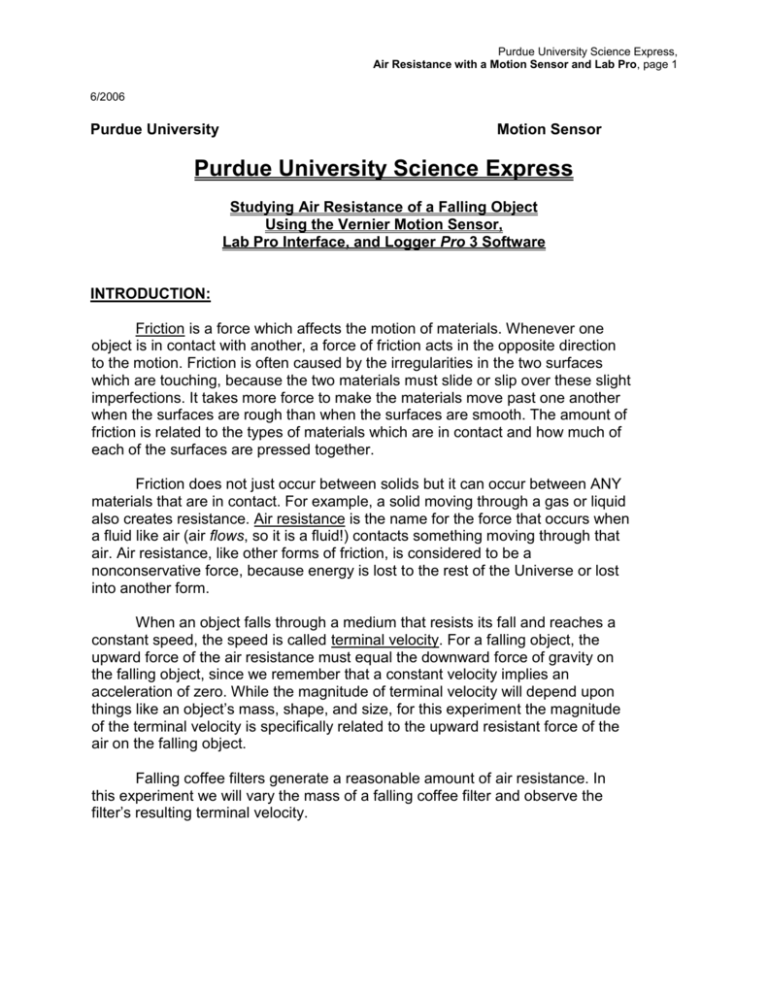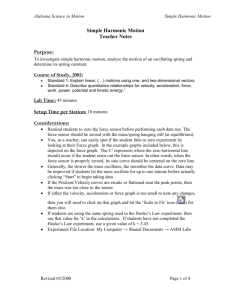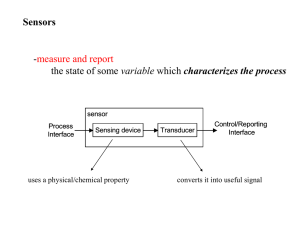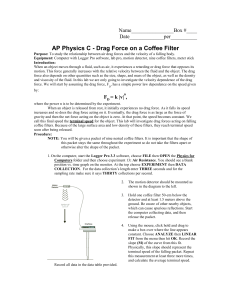
Purdue University Science Express,
Air Resistance with a Motion Sensor and Lab Pro, page 1
6/2006
Purdue University
Motion Sensor
Purdue University Science Express
Studying Air Resistance of a Falling Object
Using the Vernier Motion Sensor,
Lab Pro Interface, and Logger Pro 3 Software
INTRODUCTION:
Friction is a force which affects the motion of materials. Whenever one
object is in contact with another, a force of friction acts in the opposite direction
to the motion. Friction is often caused by the irregularities in the two surfaces
which are touching, because the two materials must slide or slip over these slight
imperfections. It takes more force to make the materials move past one another
when the surfaces are rough than when the surfaces are smooth. The amount of
friction is related to the types of materials which are in contact and how much of
each of the surfaces are pressed together.
Friction does not just occur between solids but it can occur between ANY
materials that are in contact. For example, a solid moving through a gas or liquid
also creates resistance. Air resistance is the name for the force that occurs when
a fluid like air (air flows, so it is a fluid!) contacts something moving through that
air. Air resistance, like other forms of friction, is considered to be a
nonconservative force, because energy is lost to the rest of the Universe or lost
into another form.
When an object falls through a medium that resists its fall and reaches a
constant speed, the speed is called terminal velocity. For a falling object, the
upward force of the air resistance must equal the downward force of gravity on
the falling object, since we remember that a constant velocity implies an
acceleration of zero. While the magnitude of terminal velocity will depend upon
things like an object’s mass, shape, and size, for this experiment the magnitude
of the terminal velocity is specifically related to the upward resistant force of the
air on the falling object.
Falling coffee filters generate a reasonable amount of air resistance. In
this experiment we will vary the mass of a falling coffee filter and observe the
filter’s resulting terminal velocity.
Purdue University Science Express,
Air Resistance with a Motion Sensor and Lab Pro, page 2
PURPOSE:
PART A:
Determine the relationship between the force of gravity acting on a falling object and
terminal velocity of that falling object.
PART B:
Determine the relationship between kinetic and potential energy for a falling object.
SAFETY:
1. Students should observe all laboratory safety precautions, including the wearing of
appropriate clothing, footwear, and safety goggles.
2. There should be no eating or drinking during the experiment.
3. Students who might stand on laboratory tables in order to increase the drop distance
should be monitored so that they do not fall from the tables.
4. Wash hands thoroughly after clean-up.
PRELAB QUESTIONS:
1. Describe air resistance.
2. What equation relates air resistance to force of gravity on the falling object?
3. What are some real life situations in which a person observes air resistance?
4. In one paragraph, describe your procedure and how you will analyze results.
5. What are some situations in which air resistance is a problem?
Purdue University Science Express,
Air Resistance with a Motion Sensor and Lab Pro, page 3
MATERIALS PER GROUP:
Vernier motion sensor, Lab Pro interface, and Logger Pro 3 software
large food service-size coffee filters
meter sticks
digital or platform balance
PROCEDURE for college preparatory Chemistry or Physics students:
INSTRUMENT SETUP
0. Connect the motion sensor to the computer as your teacher directs. Open the
Logger Pro program. Familiarize yourself with its capabilities. Be sure you can
collect data for moving objects and analyze the position, velocity, and
acceleration information which results.
1. Arrange the equipment so that the motion of a dropped coffee filter will be
captured by the Vernier motion sensor. Diagram your set-up as a part of your
Procedure. Your teacher will give you instructions about the arrangement of
equipment.
2. Cut one coffee filter in half. Number each filter with pen or pencil so you can
organize your data during your trials. Measure and record the masses of 1.0,
1.5, 2.0, 2.5, 3.0, 3.5, 4.0, 4.5, 5.0, and 5.5 coffee filters. Calculate and record
the weights (Fg) of each combination of filters. Record
3. Measure and record the displacement between motion sensor and the starting
point of the drops.
4. Practice dropping and recording the motion of the dropped filters. When your
technique is satisfactory, drop each filter or combination of filters. Record the
motion in graphical form with the Vernier motion sensor software. Use the
graph to determine the terminal velocity of each drop. (***This step requires
you to manipulate the data you obtain in order to determine the terminal
velocity of each filter or filter combination.***) Record.
5. Repeat each drop two more times for a total of three trials. Calculate the
average terminal velocity for each trial. Record.
Purdue University Science Express,
Air Resistance with a Motion Sensor and Lab Pro, page 4
PROCEDURE PART B
6. Use the data you have already collected and any additional data to verify (or
not) that the final kinetic energy of the falling coffee filters is equal to the initial
gravitational potential energy of the filters immediately before they are
dropped.
CLEANUP
7. Return all materials as directed by your teacher. Replace any materials from
Science Express according to their packaging information.
Purdue University Science Express,
Air Resistance with a Motion Sensor and Lab Pro, page 5
DATA:
coffee filter number
0.5
1
2
3
4
5
# of filter
Mass (g)
total mass of total mass
filters (g)
(kg)
force (N)
velocity
from graph
(m/s)
average
velocity
(m/s)
Purdue University Science Express,
Air Resistance with a Motion Sensor and Lab Pro, page 6
PROCEDURE for AP Physics students
PART A:
1. Connect motion sensor to the Lab Pro interface and computer. Open the Logger
Pro program.
2. Design a procedure to drop one coffee filter and combinations of coffee filters below
the motion sensor in order to determine the terminal velocity of the falling filter.
Use increments of 0.5 coffee filters.
3. Record and interpret data. Analyze any graphs.
PART B:
4. Use the data you have already collected and any additional data to verify (or not)
that the final kinetic energy of the falling coffee filters is equal to the initial
gravitational potential energy of the filters immediately before they are dropped.
Describe any additional procedural steps you must take.
DATA for AP Physics students
Design your own Data and Results Tables.
Purdue University Science Express,
Air Resistance with a Motion Sensor and Lab Pro, page 7
ANALYSIS AND CONCLUSIONS: Use complete sentences in your answers.
**Questions marked *** are best for AP Physics students.**
1. Expressions for air resistance commonly compare the force of air resistance to the
terminal velocity of the falling object. So, graph Force vs. Terminal Velocity, even
though Force was the independent variable and Terminal Velocity the dependent
variable. Be sure a Legend or Key is a part of your graph.
2. Graph Force vs. Terminal Velocity2. Be sure a Legend or Key is a part of your
graph. Write the equation for the best-fit straight line which results.
3. How would the results of your experiment change if the fluid through which
the objects were dropped had been more viscous? How would the graph
be affected?
4. Summarize your results from Part B. What conclusion(s) can you draw from
these results?
**5. How would the results of your experiment change if the diameter of the
coffee filter had been larger by a factor of two?
***6. Where does air resistance fit into the work-energy principle?
***7. What is Reynolds number? How would it appear in these results? How is
the Reynolds number apparent on your graph?
***8. You have traveled to Mars with the first group of colonists. What information
could you get from conducting an experiment like this on Mars?
Purdue University Science Express,
Air Resistance with a Motion Sensor and Lab Pro, page 8
TEACHER’S GUIDE
CLASS USAGE:
We suggest that students in college preparatory Physics be provided with the longer
procedure. Students in AP Physics should receive less guidance about the procedure
and should prepare their own procedures and data tables.
CURRICULUM INTEGRATION: Application to the Indiana State Standards
Physics:
The Relationships Between Motion and Force P. 1.5, P.1.6, P.1.7, P.1.9, P. 1.11
Historical Perspectives of Physics P. 2.1
Mathematics
Algebra I:
Standard 3, Relations and Functions
Standard 4, Graphing Linear Equations and Inequalities
Standard 9, Mathematical Reasoning and Problem Solving
Geometry: Standard 8, Mathematical Reasoning and Problem Solving
Algebra II: Standard 7, Logarithmic and Exponential Functions
Precalculus: Standard 2: Logarithmic and Exponential Functions
Standard 9: Mathematical Reasoning and Problem Solving
Purdue University Science Express,
Air Resistance with a Motion Sensor and Lab Pro, page 9
TEACHER’S PRELIMINARY NOTES AND PREPARATIONS:
This procedures uses the newer Vernier motion sensor probe, laptop computers,
Logger Pro 3 software, and Lab Pro Interface
1.
In a separate lesson, the teacher needs to become familiar with the motion sensor
and software. Students then need to be instructed in how to use the software and
how to analyze the data. THIS equipment collects data more quickly and visibly
than MACMOTION. Less manipulation is needed before velocity values are
determined.
2.
We found better results when the sensor was clamped to the ceiling and filters were
dropped BELOW the sensor, rather than to place the sensor on the floor and to drop
the filters ONTO the sensor. The “flutter” and “float” of the filters occurred in both
procedures, but the sensor collected more reliable and consistent data for the filter
dropped BELOW the sensor than for the filter dropped ONTO the sensor. Be sure
the sensor is firmly clamped or attached to the ceiling. We used the motion sensor
clamp which was provided with the sensor to attach the sensor to a metal ceiling
grid. There was a little sway to the sensor platform but practice and patience made
the equipment work.
3.
If one filter dropped alone does not provide reasonable data, try dropping SETS of
filters (2 filters, 4 filters, 6 filters, etc). An alternative method might be to tape a small
mass into the bottom of one filter and to account for this extra mass in every trial.
4.
Be sure students can stand safely on the lab table tops in order to reach the sensor.
They should wear sturdy shoes and should be monitored so that they keep their
balance. A ladder may be an option in some laboratories.
5.
Remember that the motion sensor generates a cone of sensitivity and that the
sensor records information within a 0.5 m to 2.5 m distance.
6.
Minimize air currents in the room. Don’t do this experiment directly beneath any air
vents.
7.
We suggest writing numbers onto the coffee filters for identification purposes before
they are massed. We used the same half coffee filter in all drops.
Purdue University Science Express,
Air Resistance with a Motion Sensor and Lab Pro, page 10
SAMPLE DATA AND GRAPHS.
See attached graphs which were prepared with Graphical Analysis III (older version).
TIME NEEDED FOR THIS EXPERIMENT:
1. One class period should be adequate for collection of data.
SAFETY AND DISPOSAL:
1. Don’t let anyone fall from a lab table.
2. Be sure all materials are repackaged according to Science Express specifications
and notify Science Express of any problems with equipment or samples.
3. Be sure students wash their hands thoroughly after cleaning up.
ASSESSMENT:
1. Students will answer Prelab Questions.
2. Students will answer Analysis and Conclusions questions.
3. Students will prepare and analyze graphs.
4. Material from appropriate chapters will appear on other assignments, including
homework and tests or exams.
Purdue University Science Express,
Air Resistance with a Motion Sensor and Lab Pro, page 11
POSSIBLE ANSWERS TO PRELAB QUESTIONS:
1. Describe air resistance.
sample answer
2. What equation relates air resistance to force of gravity on the falling object?
Fg = FR, where Fg = weight of falling object and FR = upward air resistance
3. What are some real life situations in which a person observes air resistance?
Air resistance is seen when people parachute, a seed is dispersed by the wind, or
a leaf falls to the ground.
4. In one paragraph, describe your procedure and how you will analyze results.
Set up the motion sensor and computer in order to measure distance, velocity,
and acceleration for a falling coffee filter. Arrange the equipment so that the filter
will fall AWAY from the detector. Drop filters in increasing increments of 0.5 filters.
Mass the filters and determine how much they weigh. This downward force is
exactly balanced by an upward force of air resistance when the filters fall with
constant velocity. Collect data and determine the terminal velocity of each filter or
combination of falling filters. Graph Force vs. Velocity and manipulate the data or
graph to generate a best fit line. Write an equation for any best-fit lines. Finally,
calculate the initial gravitational potential energy of the filter and the final kinetic
energy of the filter and determine if these two values are equal. Discuss the
results.
5. What are some situations in which air resistance is a problem?
Swimmers, normal and race car drivers, golf ball manufacturers, and astronauts
returning to Earth are just a few of the people who are concerned about the effects
of air resistance.
Purdue University Science Express,
Air Resistance with a Motion Sensor and Lab Pro, page 12
POSSIBLE STUDENT ANSWERS TO ANALYSIS AND CONCLUSIONS
QUESTIONS:
1. Expressions for air resistance commonly compare the force of air resistance to the terminal velocity of the
falling object. So, graph Force vs. Terminal Velocity, even though Force was the independent variable
and Terminal Velocity the dependent variable. Be sure a Legend or Key is a part of your graph.
The graph of Force vs. Terminal Velocity should be a curve; it should be a
parabola.
2. Graph Force vs. Terminal Velocity2. Be sure a Legend or Key is a part of your graph. Write the
equation for the best-fit straight line which results.
A graph of Force vs. Terminal Velocity 2 is a best fit straight line. The equation we
determined is Force = (0.0422 N/m 2/s 2) x Velocity 2.
3. How would the results of your experiment change if the fluid through which the objects were
dropped had been more viscous? How would the graph be affected?
When the medium is more viscous, the dropped object will have less velocity.
Since the slope of our best fit line = Force / Velocity2, if the velocity is smaller
then the slope will be larger. So, we predict that the slope of the Force vs.
Velocity 2 in a Viscous Material will be MORE than the slope in the less
viscous material. Students could show this conclusion mathematically.
4. Summarize your results from Part B. What conclusion(s) can you draw from these results?
Students will need to calculate final kinetic energy from the equation kinetic
energy = (1/2) (mass) (velocity2) and compare it to gravitational potential
energy = (mass) (gravity constant) (height). The data should NOT indicate
that the kinetic energy at landing on the floor is equal to the gravitational
potential energy before the filter is dropped. Because air resistance is a
nonconservative force, the initial gravitational potential energy should not
equal the final kinetic energy. Remind students that friction is another
common nonconservative force.
Purdue University Science Express,
Air Resistance with a Motion Sensor and Lab Pro, page 13
**5. How would the results of your experiment change if the diameter of the coffee filter had been
larger by a factor of two?
A larger diameter filter has more mass and weighs more (has more Fg), will
produce more “drag,” and a smaller terminal velocity. A graph of this
information would show a greater slope.
***6. Where does air resistance fit into the work-energy principle?
Air resistance is a nonconservative force, so it is a part of the term
Worknonconservative in this equation:
Worknonconservative = change in kinetic energy + change in potential energy
***7. What is Reynolds number? How would it appear in these results? How is the Reynolds number
apparent on your graph?
Reynolds number relates density of air, velocity of the falling object, diameter
of the object, and viscosity of the air. The graph of F = (slope) v2 includes
the Reynolds number within the slope value. It can be shown that the
slope = (density)(area) / Reynolds number.
***8. You have traveled to Mars with the first group of colonists. What information could you get from
conducting an experiment like this on Mars.
Student answers.
Purdue University Science Express,
Air Resistance with a Motion Sensor and Lab Pro, page 14
RESOURCES:
useful websites:
for the Indiana State Standards:
www.doe.state.in.us/standards
We strongly recommend
that teachers verify
and check all websites
before asking students to
use this information.
for information about how things work:
www.howthingswork.org
for information about the technology and hints:
www.vernier.com
http://education.ti.com/educationportal/sites/US/homePage/index.html
for examples of falling things:
www.glenbrook.k12.il.us/GBSSCI/PHYS/mmedia/newtlaws/efar.html
http://www.grc.nasa.gov/WWW/K-12/airplane/falling.html
http://hyperphysics.phy-astr.gsu.edu/hbase/airfri.html
for Reynolds number:
http://carini.physics.indiana.edu/E105/texture.html
Purdue University Science Express,
Air Resistance with a Motion Sensor and Lab Pro, page 15
text references:
Gastineau, J.; Appel, K., Bakken, C. Sorensen, R. and Vernier, D. Physics with
Calculators. Vernier Software and Technology, 2000.
Giancoli, D. C. Physics: Principles with Applications. 6th ed. Pearson/Prentice-Hall.
2005. Ch. 6, “Work and Energy.”
Hewitt, P. R. Conceptual Physics. Pearson/Prentice Hall. 2006. “Ch.5, Forces and
Acceleration.”
Serway, R.A. and Faughn, J.S. College Physics. 6th ed. Thomson/Brooks.Cole. 2003.
Ch.5, “Energy.”
Serway, R.A. and Faughn, J.S. Physics. Holt, Rinehart, and Winston. Orlando. 2006.
Ch. 2, “Motion in One Dimension,” ch. 3, “Two Dimensional Motion and Vectors,” and
ch. 4, “Forces and Laws of Motion.”
Debra Beck
Gregg Beck
Science Express 2006
Purdue University Science Express,
Air Resistance with a Motion Sensor and Lab Pro, page 16
GRAPHS AND IMAGES:
Purdue University Science Express,
Air Resistance with a Motion Sensor and Lab Pro, page 17
Purdue University Science Express,
Air Resistance with a Motion Sensor and Lab Pro, page 18
Purdue University Science Express,
Air Resistance with a Motion Sensor and Lab Pro, page 19










